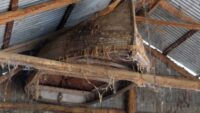 The wooden lifeboat that carried the crew to safety after their ship wrecked off the western coast of Australia in 1891 has been found intact in the rafters of a hay shed. Archaeologist Bob Sheppard was taking a tour of the old farm’s historic outbuildings. John Grigson showed him the nifty boat in the rafters and told him it was the lifeboat of the Maid of Lincoln. The remains of the Maid were never found, so this is the only known artifact from the shipwreck and it is in excellent condition.
The wooden lifeboat that carried the crew to safety after their ship wrecked off the western coast of Australia in 1891 has been found intact in the rafters of a hay shed. Archaeologist Bob Sheppard was taking a tour of the old farm’s historic outbuildings. John Grigson showed him the nifty boat in the rafters and told him it was the lifeboat of the Maid of Lincoln. The remains of the Maid were never found, so this is the only known artifact from the shipwreck and it is in excellent condition.
The Maid of Lincoln was a 12-horsepower wooden steamer built in Port Lincoln in 1885. It primarily served harbor duty for its first few years. In 1889 it caught fire while at anchor in South Bay and was heavily damaged in the conflagration. It was repaired and put back to work.
It wasn’t fire damage that brought it down in the end. The ship set out on April 11, 1891, carrying a load of guano from the Abrolhos Islands, rich seabird nesting sites, to Bunbury. Its captain, William Millar, ordered changes to the course heading but stayed below deck so much that he didn’t realize it was getting to close to the coast and that the visibility was too poor for the helmsman to adjust. At 2:00 AM, the Maid of Lincoln struck a reef eight miles south of Jurien Bay off Hill River and quickly sank.
The captain, a half-dozen crew members and one stowaway who only made his presence known when the ship was rapidly filling with water, managed to get on the ship’s lifeboat and launch it before the ship went down, but they didn’t have the time to salvage any supplies. Half of the crew didn’t even have the time to put shoes on. When they made it safely to Jurien Bay, the shoeless survivors stayed behind on the beach and the other half of the party went inland to Cockleshell Gully where they reached the Grigson farm. John Grigson’s grandfather transported the refugees to Geraldton on by horse and cart. Captain Millar gave the lifeboat to Grigson to thank him for his aid.
The family used it as a fishing boat and kept it out on the veranda. Around 70 or 80 years ago, they retired it permanently and stashed it up in the shed they’d built in 1901. It has been peacefully collecting spider webs ever since. The rafters are in worse condition than the boat. Devoured by white ants, they are not what you would call structurally sound at this point, and the boat was at risk of collapse.
 Removing the boat was a delicate operation. An archaeologist and expert on ropes was enlisted and he designed a cunning rig made of old ladders, fencing and ropes to carefully raise the boat off the rafters and then lower it to the ground. They didn’t know how heavy it was or how it might react to the pressures of transport, but the old lifeboat proved remarkably sturdy yet. The team was able to remove it intact without incident.
Removing the boat was a delicate operation. An archaeologist and expert on ropes was enlisted and he designed a cunning rig made of old ladders, fencing and ropes to carefully raise the boat off the rafters and then lower it to the ground. They didn’t know how heavy it was or how it might react to the pressures of transport, but the old lifeboat proved remarkably sturdy yet. The team was able to remove it intact without incident.
For now it resides in a weather-proof storage shed. Sheppard hopes to find a permanent home for it in a museum. The Grigson family has stipulated that it must remain in Jurien Bay for the community to enjoy this rare piece of its maritime history.